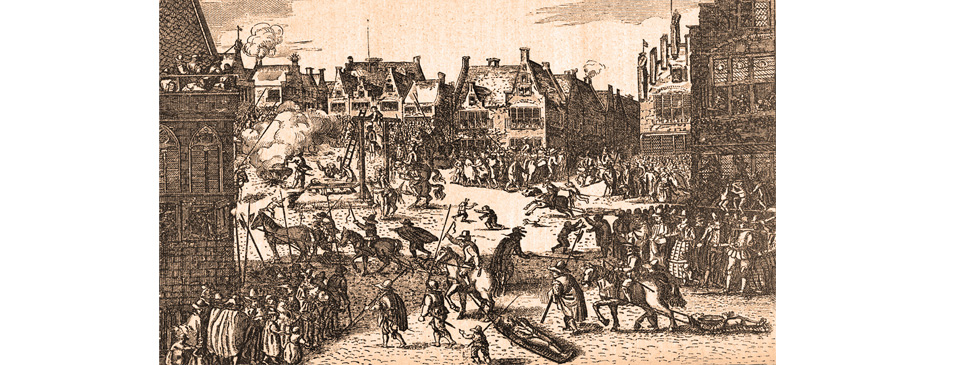The Gunpowder Plot

The execution of the Gunpowder Plot conspirators as imagined by the Dutch printmaker Claes Jansz Visscher c.1606
Probably the best-known attempt to assassinate a British monarch is the ‘Gunpowder Plot’ conspiracy of 1605. It is still celebrated in England every 5th November as ‘Guy Fawkes Night’.
During the latter decades of the 16th century and throughout the next there was a general intolerance of Catholics by many of the Protestant majority in Britain. Most of the Catholic minority were loyal to the monarchy but there was a relatively small number of extremists and, as was often the case, their threat to the Protestant establishment resulted in exaggerated rumours of plots and insurrection, resulting in anti-Catholic laws and occasional suppression.
When, upon the death of Elizabeth I in 1603, James VI of Scotland inherited the English Crown (as James I of England) there was no doubt a mixture of concern and hope amongst Catholics as to his intentions. It seems that James was privately tolerant of his Catholic subjects, provided they were loyal to him. Yet political expedience and the deep-rooted anti-Catholic sentiments of many amongst his ministers and subjects dictated that he should be seen to strongly support the Anglican traditions and present a hard line against papists. In 1604, for example, he encouraged legislation against Jesuit priests; and in February 1605 he initiated a crackdown on ‘recusants’ – those who refused to attend Church of England services – of whom more than 5,500 are estimated to have been prosecuted. Catholic extremists, who wished for an overthrow of the Protestant monarchy and government through an invasion by a foreign Catholic power, were also no doubt despondent that peace had finally been made with Spain.
A number of Catholic gentry, many of whom had suffered one way or another for their religious beliefs, came together in 1604 to undertake a plan to assassinate the King, members of the Privy Council, and MPs by blowing up the Houses of Parliament during the ceremony for the State Opening. The initial plotters were Thomas Percy, Thomas Wintour, Robert Catesby, John Wright and Guy Fawkes. Catesby was the son of Sir William Catesby who had previously been imprisoned for harbouring Father Edmund Campion, the leader of English Jesuits. Percy was related to the Earls of Northumberland who had been involved in previous Catholic uprisings. Wright and Wintour were gentry who had experienced Catholic suppression.
The Yorkshireman Guy Fawkes spent ten years as a soldier fighting in the Low Countries for the Archduke of Austria within the English regiment of Sir William Stanley, a Catholic exile. In 1603 he visited the King of Spain to discuss the situation of English Catholics and while there worked with one of the future Gunpowder Plot conspirators to obtain support for an invasion of England. He then travelled to Brussels where he was introduced to Wintour who was probably already working on the plot.
In May 1604 the conspirators met at the Duck & Drake inn on the Strand and agreed their commitment to the scheme. Fawkes assumed the identity of Cateby’s servant, John Johnson. Catesby initially hired lodgings and Fawkes was put in charge of digging a tunnel towards Westminster. This proved to be too difficult and in March 1605 a cellar below Parliament was acquired by Thomas Percy where 36 barrels of gunpowder were hidden behind some wood and pieces of iron. By this time several other people had been drawn into the group of conspirators, including the brothers of Wright and Wintour.
The next sitting of Parliament was continually delayed, and the gunpowder was beginning to spoil, so Fawkes was sent back to Flanders to obtain replacement explosive. While this was happening the group became even larger with the addition of a number of others, including Cateby’s cousin Thomas Tresham. All the conspirators, except Fawkes and one other, were related through family ties.
On 26th October 1605 an anonymous letter was received at his home in Hoxton by Lord Monteagle, a lapsed Catholic, warning him not to attend the Opening of Parliament, and it is possible that this letter was sent by Tresham. Monteagle immediately sent it on to Robert Cecil, Secretary of State. Several of the conspirators learnt of the letter but in the following days concluded that no action would come as a result. On 3rd November the main conspirators met, and plans were made for leaving London. Fawkes was to fire the gunpowder, then leave for Flanders to spread news of the success on the Continent.


